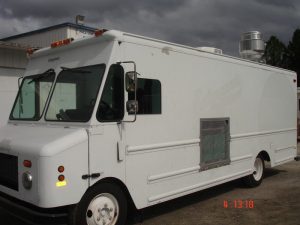If you operate a food truck business long enough at some point you’ll experience a break down. As you might expect, towing a food truck is going to take some additional considerations than a typical automobile.
Many people mistakenly believe that if their vehicle can tow a trailer, it’s automatically safe and properly loaded. This is not the case. Overloading or improperly loading can lead to unpredictable and unsafe handling once you get out on the road, especially if you plan to take it out on a fast road like an interstate.
In this blog post, we provide some tips and specific pieces of advice for towing a food truck so you don’t damage the mobile kitchen while in transit to the repair shop.
Plan Your Route
Plan Your Route: Avoid roads with sharp turns, low bridges, or steep inclines. Use a GPS or mapping service that offers routes for larger vehicles or trucks. Make a plan for the best way to get to the repair shop where you can avoid potential hazards and heavy traffic.
Regularly Check: Stop periodically to check the hitch, chains, and other connections. Ensure that the food truck’s doors, windows, and equipment remain secure before you start driving. If possible, get a vehicle to follow along behind you to notify other drivers.

Follow these guidelines before towing a food truck.
Secure All Items: Before towing, make sure all equipment inside the food truck is secured. Close and lock all doors and windows. While you’re at it, make sure to take out any valuable items like cash, POS, or computer systems you may have onboard.
Check the Tires: Ensure that the tires on both the towing vehicle and the food truck are properly inflated and in good condition.
Be Aware of Windy Conditions: If you encounter strong winds, reduce your speed, and keep a firm grip on the steering wheel. Avoid making sudden lane changes and take it slow. Windy conditions can come out of now where in sparsely populated areas specifically. If you anticipate high winds, consider delaying the transport of your food truck if possible.
Check Proper Lighting: Ensure that all lights on the food truck, including brake lights, turn signals, and running lights, are functional. Use towing mirrors to have a clear view of the road behind.
Have an Emergency Kit: Always carry an emergency kit that includes basic tools, a flashlight, flares, a first aid kit, and other essential items. If you have the option to travel during the day this is preferred in case there are unanticipated issues that arise.
Proper Loading
Towing Capacity: It’s crucial to know your vehicle’s maximum trailer rating or towing capacity. This rating is based on various criteria, including the vehicle’s weight, engine, gear ratio, brake size, and tires. Always refer to the owner’s manual or manufacturer’s towing guide for accurate information. Before a towing service hooks up your food truck, ask if the weight capacity is sufficient. The typical food truck weighs 19,000 – 30,000 pounds.
Aim to keep the total trailer weight within 10% of the vehicle’s maximum tow rating for optimal performance. For instance, if a truck has an 300,000 pound towing capacity, the ideal loaded trailer weight should be around 30,000 pounds.

Hawaiian Food Truck Built by M&R Specialty Trailers and Trucks
Overloading Concerns: Occasional overloading for short distances might not cause immediate damage, but it can severely affect the vehicle’s stopping distances and handling. Over time, overloading can lead to premature wear on various components, increasing maintenance costs and potentially leading to accidents.
Towing a food truck is not as straightforward as it might seem. It’s essential to understand weight limits, use the correct hitch, and ensure proper loading to guarantee safety. Being informed and cautious can prevent accidents and ensure the smooth operation of your mobile food business.
Remember, always prioritize safety and ensure that your towing setup adheres to all legal and manufacturer guidelines. We suggest contacting a professional towing company with experience transporting large vehicles to the repair shop.

Leave A Comment